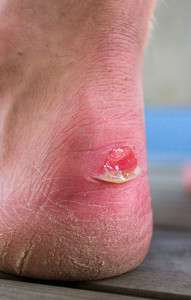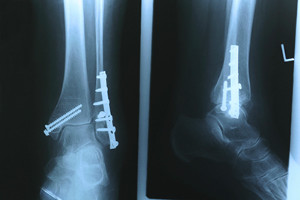
 A common ailment that many diabetics have are foot problems; managing blood glucose levels, however, may help to keep the feet healthy. When nerve damage occurs in diabetics, it may cause pain and tingling, including possible numbness in the foot. Serious infections may be the result of this and can possibly lead to gangrene. It’s important to manage your diabetes; this may involve following a foot care plan. It’s crucial to check your feet daily, which will enable you to notice problems before they get worse. Some conditions to look for may be cuts, sores, or ingrown toenails. Washing your feet regularly will help you become aware of these issues. Trimming the toenails straight across the toe with clippers can help prevent the skin from being cut and can keep the toenails healthy. Consult with a podiatrist for a proper diagnosis and to learn of the treatment options available for diabetic feet.
A common ailment that many diabetics have are foot problems; managing blood glucose levels, however, may help to keep the feet healthy. When nerve damage occurs in diabetics, it may cause pain and tingling, including possible numbness in the foot. Serious infections may be the result of this and can possibly lead to gangrene. It’s important to manage your diabetes; this may involve following a foot care plan. It’s crucial to check your feet daily, which will enable you to notice problems before they get worse. Some conditions to look for may be cuts, sores, or ingrown toenails. Washing your feet regularly will help you become aware of these issues. Trimming the toenails straight across the toe with clippers can help prevent the skin from being cut and can keep the toenails healthy. Consult with a podiatrist for a proper diagnosis and to learn of the treatment options available for diabetic feet.
Diabetic foot care is important in preventing foot ailments such as ulcers. If you are suffering from diabetes or have any other concerns about your feet, contact Dr. Russell J. Ellicott from Augusta Foot Center. Dr. Ellicott can provide the care you need to keep you pain-free and on your feet.
Diabetic Foot Care
Diabetes affects millions of people every year. The condition can damage blood vessels in many parts of the body, especially the feet. Because of this, taking care of your feet is essential if you have diabetes, and having a podiatrist help monitor your foot health is highly recommended.
The Importance of Caring for Your Feet
Patients with diabetes should have their doctor monitor their blood levels, as blood sugar levels play such a huge role in diabetic care. Monitoring these levels on a regular basis is highly advised.
It is always best to inform your healthcare professional of any concerns you may have regarding your feet, especially for diabetic patients. Early treatment and routine foot examinations are keys to maintaining proper health, especially because severe complications can arise if proper treatment is not applied.
If you have any questions please feel free to contact our office located in Augusta, GA. We offer the newest diagnostic and treatment technologies for all your foot and ankle needs.
Read more about Diabetic Foot Care If you realize your toenail is growing into the surrounding skin in addition to becoming red and tender, the chances are good that you are experiencing an ingrown toenail. Usually the big toe is affected and may bleed or have pus coming from the area. Common causes may be from injuries such as a stubbed toe, poorly cut toenails, or from shoes that may not fit correctly. Proper treatment is crucial for ingrown toenails in order to prevent infection. This may include changing socks regularly, cutting the nail straight across to prevent digging into the skin that surrounds it, and keeping the feet clean by washing them every day. Minor surgery for severe cases may include a partial or total nail avulsion. Typically, this means a local anaesthetic is used for numbing the toe, and the edges of the toenail may be cut away or the nail fully removed. If you think you may have ingrown toenails, a consultation with a podiatrist is advised for a proper diagnosis and treatment.
If you realize your toenail is growing into the surrounding skin in addition to becoming red and tender, the chances are good that you are experiencing an ingrown toenail. Usually the big toe is affected and may bleed or have pus coming from the area. Common causes may be from injuries such as a stubbed toe, poorly cut toenails, or from shoes that may not fit correctly. Proper treatment is crucial for ingrown toenails in order to prevent infection. This may include changing socks regularly, cutting the nail straight across to prevent digging into the skin that surrounds it, and keeping the feet clean by washing them every day. Minor surgery for severe cases may include a partial or total nail avulsion. Typically, this means a local anaesthetic is used for numbing the toe, and the edges of the toenail may be cut away or the nail fully removed. If you think you may have ingrown toenails, a consultation with a podiatrist is advised for a proper diagnosis and treatment.
Ingrown toenails can become painful if they are not treated properly. For more information about ingrown toenails, contact Dr. Russell J. Ellicott of Augusta Foot Center. Dr. Ellicott can provide the care you need to keep you pain-free and on your feet.
Ingrown Toenails
Ingrown toenails occur when a toenail grows sideways into the bed of the nail, causing pain, swelling, and possibly infection.
Causes
Prevention
Because ingrown toenails are not something found outside of shoe-wearing cultures, going barefoot as often as possible will decrease the likeliness of developing ingrown toenails. Wearing proper fitting shoes and using proper cutting techniques will also help decrease your risk of developing ingrown toenails.
Treatment
Ingrown toenails are a very treatable foot condition. In minor cases, soaking the affected area in salt or antibacterial soaps will not only help with the ingrown nail itself, but also help prevent any infections from occurring. In more severe cases, surgery is an option. In either case, speaking to your podiatrist about this condition will help you get a better understanding of specific treatment options that are right for you.
If you have any questions please feel free to contact our office located in Augusta, GA. We offer the newest diagnostic and treatment technologies for all your foot and ankle needs.
Read more about Ingrown Toenail Care Diabetics need to take proper care of their feet due to their condition. Diabetes often causes poor blood circulation and neuropathy, which causes sensation loss in the extremities and lower limbs. If a diabetic gets a blister on his or her foot, he or she may not even realize it exists. If left unchecked, a blister can become infected and potentially infect the rest of the foot; in worst cases, this may then require amputation. Prevention is key, so wearing well-fitted shoes, conducting everyday foot exams, maintaining proper foot care, and visiting a podiatrist every several months can all help prevent a foot ulcer. If you have a foot ulcer and are diabetic, it is recommended that you see a podiatrist who can provide proper care and attention to the wound.
Diabetics need to take proper care of their feet due to their condition. Diabetes often causes poor blood circulation and neuropathy, which causes sensation loss in the extremities and lower limbs. If a diabetic gets a blister on his or her foot, he or she may not even realize it exists. If left unchecked, a blister can become infected and potentially infect the rest of the foot; in worst cases, this may then require amputation. Prevention is key, so wearing well-fitted shoes, conducting everyday foot exams, maintaining proper foot care, and visiting a podiatrist every several months can all help prevent a foot ulcer. If you have a foot ulcer and are diabetic, it is recommended that you see a podiatrist who can provide proper care and attention to the wound.
Blisters are prone to making everyday activities extremely uncomfortable. If your feet are hurting, contact Dr. Russell J. Ellicott of Augusta Foot Center. Dr. Ellicott can provide the care you need to keep you pain-free and on your feet.
Foot Blisters
Foot blisters develop as a result of constantly wearing tight or ill-fitting footwear. This happens due to the constant rubbing from the shoe, which can often lead to pain.
What are Foot Blisters?
A foot blister is a small fluid-filled pocket that forms on the upper-most layer of the skin. Blisters are filled with clear fluid and can lead to blood drainage or pus if the area becomes infected.
How do Blisters Form?
Blisters on the feet are often the result of constant friction of skin and material, usually by shoe rubbing. Walking in sandals, boots, or shoes that don’t fit properly for long periods of time can result in a blister. Having consistent foot moisture and humidity can easily lead to blister formation.
Prevention & Treatment
It is important to properly care for the affected area in order to prevent infection and ease the pain. Do not lance the blister and use a Band-Aid to provide pain relief. Also, be sure to keep your feet dry and wear proper fitting shoes. If you see blood or pus in a blister, seek assistance from a podiatrist.
If you have any questions, please feel free to contact our office located in Augusta, GA. We offer the newest diagnostic and treatment technologies for all your foot care needs.
Read more about Blisters on the Feet When is comes to podiatric care, podiatrists strive to exhaust all nonsurgical treatment options first. However, there are times and many reasons why people may need foot surgery. Some of these include bunions, which are bony bumps that form on the base of big toe. Surgery may involve straightening the big toe if symptoms continue for a long period of time. Permanently bent toes, also called hammertoes, can be eased by removing the deformed joint between the toes, which improves flexibility. Rheumatoid arthritis can leave the joints in the foot damaged by inflammation. The exact procedure will depend on the severity of this condition, but surgery is commonly performed on the big toe in order to make walking easier. If the ankle is damaged, ankle fusion may be necessary to fuse the talus bone to the tibia, thereby relieving pain in the ankle. Screws are used to hold the bones together, and will heal for 12-14 weeks. Normal shoes can be worn soon afterward and it will be easier to walk. Please consult with a podiatrist to discuss all options when it comes to foot-related conditions.
When is comes to podiatric care, podiatrists strive to exhaust all nonsurgical treatment options first. However, there are times and many reasons why people may need foot surgery. Some of these include bunions, which are bony bumps that form on the base of big toe. Surgery may involve straightening the big toe if symptoms continue for a long period of time. Permanently bent toes, also called hammertoes, can be eased by removing the deformed joint between the toes, which improves flexibility. Rheumatoid arthritis can leave the joints in the foot damaged by inflammation. The exact procedure will depend on the severity of this condition, but surgery is commonly performed on the big toe in order to make walking easier. If the ankle is damaged, ankle fusion may be necessary to fuse the talus bone to the tibia, thereby relieving pain in the ankle. Screws are used to hold the bones together, and will heal for 12-14 weeks. Normal shoes can be worn soon afterward and it will be easier to walk. Please consult with a podiatrist to discuss all options when it comes to foot-related conditions.
Foot surgery is sometimes necessary to treat a foot ailment. To learn more, contact Dr. Russell J. Ellicott of Augusta Foot Center. Dr. Ellicott will assist you with all of your foot and ankle needs.
When Is Surgery Necessary?
Foot and ankle surgery is generally reserved for cases in which less invasive, conservative procedures have failed to alleviate the problem. Some of the cases in which surgery may be necessary include:
What Types of Surgery Are There?
The type of surgery you receive will depend on the nature of the problem you have. Some of the possible surgeries include:
Benefits of Surgery
Although surgery is usually a last resort, it can provide more complete pain relief compared to non-surgical methods and may allow you to finally resume full activity.
Surgical techniques have also become increasingly sophisticated. Techniques like endoscopic surgery allow for smaller incisions and faster recovery times.
If you have any questions please feel free to contact our office located in Augusta, GA. We offer the newest diagnostic and treatment technologies for all your foot and ankle needs.
Read more about Foot Surgery